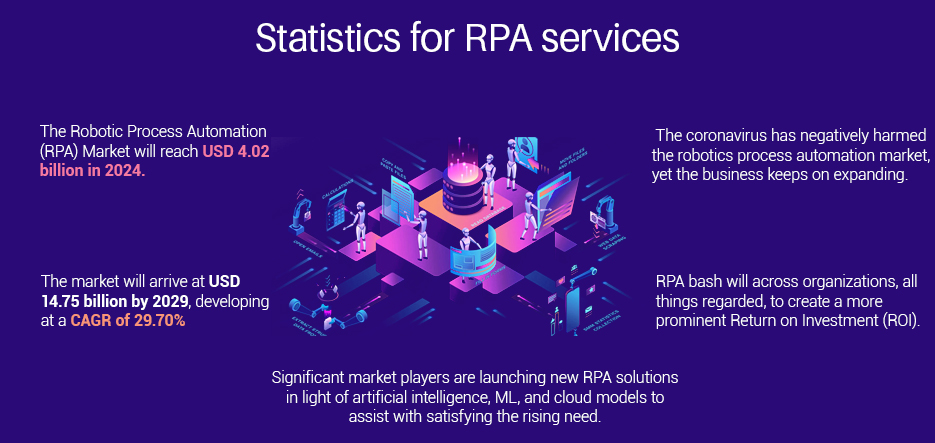Table of Contents
Organizations are ceaselessly looking for innovative ways of further developing proficiency and development by smoothing out their processes in the rapidly changing business environment of today. Robotic Process Automation (RPA) is one such innovation that has been popular lately. While it is a somewhat new area for many, the improvements many are seeing already are immense. Top software development companies uses RPA throughout their development cycle.
53% of the respondents to a recent Deloitte survey have already activated implementation, and over the next two years, as many as 72% are expected to engage actively in the automation venture. Five years from now, unless a dramatic change occurs, almost all businesses will have automated most repetitive, menial jobs. This makes a lot of sense if you consider the fact that early adopters already reported payback at less than 12 months, with software robots providing an average of 20% of full-time equivalent (FTE) capacity. Moreover, the expectations of the Deloitte respondents are met or even exceeded concerning RPA effectiveness when it comes to:
- Improved adherence (92%)
- Upgraded quality (90%)
- Boosted productivity (86%)
- Cost deduction (59%)
From activities common to all organizations, such as HR / Payroll, Sales, Finance, and Operations, to industry-specific activities, like the revenue cycle functions in healthcare, RPA can be implemented across a vast topography of operational processes.
RPA has changed business operations for companies in a variety of sectors by automating repetitive, rule-based procedures. This essay will examine RPA’s realm, as well as its uses, advantages, and potential effects on enterprises.

What is Robotic process automation (RPA)?
Should “machine learning” evoke visions of a dark and dismal future akin to The Matrix coupled with The Terminator, then “robotic process automation” must represent the stage in which machines ascend to govern humanity with merciless efficiency.
First things first: Robotic automation does not include any robots.
Thankfully, robotic process automation (RPA) does not entail any such aspects, possibly except efficiency. This automation software doesn’t even use any robots.
According to experts, “robotic process automation is not a physical [or] mechanical robot.“
In summary, RPA is the automation of repetitive processes and methodologies through the use of software robots, or “bots”. These artificial intelligence (AI) bots are made to look and behave like individuals. Overall, they can work with different software programs and do activities like data entry, data extraction, and report creation.
RPA use machine learning and artificial intelligence to evaluate and understand the steps needed to finish a task, allowing the bots to execute these tasks quickly and accurately.
According to a recent report by Gartner, RPA software revenue grew by 63.1% in 2020, reaching $1.58 billion. This significant growth is attributed to the increasing adoption of RPA solutions by businesses worldwide. Furthermore, experts believe that by 2025, organizations will be able to lower operational costs by 30% by combining RPA with other complementary technologies.
Market Stats for RPA Services
The market for RPA services is witnessing a rapid expansion, with several key players offering their expertise in this domain. However, according to a study by Grand View Research, the global RPA market size was valued at $1.57 billion in 2020 and is expected to grow at a compound annual growth rate (CAGR) of 32.8% from 2021 to 2028.
| Study Period | 2021 – 2029 |
|---|---|
| Market Size (2024) | USD 4.02 Billion |
| Market Size (2029) | USD 14.75 Billion |
| CAGR (2024 – 2029) | 29.70 % |
| Fastest Growing Market | Asia Pacific |
| Largest Market | North America |
This growth is attributed to the increasing demand for automation solutions to improve productivity and reduce costs in various industries.
The Benefits of Integrating RPA in Your Business Processes
Integrating robotic automation into your business processes offers a plethora of benefits that can significantly transform your organization’s operations. Firstly, RPA managed services enable businesses to enhance operational efficiency by automating repetitive tasks, reducing the risk of human error, and increasing productivity. Furthermore, by offloading mundane tasks to software robots, employees can focus on more strategic and value-added activities, ultimately driving innovation and growth.
RPA offers various benefits for organizations hoping to smooth out their cycles and further develop effectiveness.
1. Increased precision
By incorporating robotic process automation into your business processes, you can lessen mistakes and increment accuracy via robotizing repetitive tasks. This recovery time also permits your employees to focus on more key and value-added activities. Furthermore, it can upgrade consumer loyalty by empowering quicker response times and further developing and improving overall robotic process automation service providers quality.
2. Cost Savings
Besides, coordinating robotic automation in your business cycles can produce huge cost savings. Via automating redundant tasks, you can decrease the requirement for difficult work and limit human errors, bringing about expanded efficiency and reduced functional expenses.
3. Adaptability
Automation likewise gives adaptability, permitting your business to deal with bigger assignments without the requirement for extra resources. With these advantages, incorporating RPA can incredibly work on the proficiency and adequacy of your business tasks.
4. Further developed data security-
Additionally, it can likewise further develop compliance and data security inside your business processes. Via automating tasks, RPA guarantees the processes are reliably followed, diminishing the risk of non-compliance. Furthermore, robotic process automation also improves data security by limiting the requirement for a manual data section, which is inclined to errors and intervals. With robotic automation, you can enjoy the harmony of your intellect realizing that your business processes are both consistent and secure.
5. Further developed decision making
Besides, coordinating RPA in your business processes can likewise produce better navigation. Via automating data collection and analysis, RPA can give lasting experiences and analyses that can enlighten critical business choices. This can assist your organization with remaining in front of the opposition and settling on additional informed decisions given exact and cutting-edge data. With automation, you can have a data-driven way to deal with decision-making, bringing about improved outcomes and extended accomplishment.
6. Continuous Improvement-
Furthermore, coordinating Robotic automation in your business processes can encourage a culture of development and constant improvement. Via automating tedious tasks, your workers can focus on investigating unknown thoughts and tracking down effective fixes to complex issues.
RPA can act as a momentum for development, permitting your organization to remain agile and adjust to changing business sector requests. Furthermore, with RPA, you can establish a workplace that energizes trial and error and drives business development.
7. Smoothed out client support
In addition, coordinating RPA in your business cycles can likewise smooth out client support. Via automating tasks, for example, data entry and data recovery, RPA can give quicker and more exact responses to client requests. This further develops consumer loyalty as well as opens up your representatives’ chance to focus on additional mind-boggling client needs. With RPA, you can convey uncommon client care and simulate solid relationships with your clients.
8. Optimized resource allocation
Also, coordinating Robotic process automation in your business processes can advance resource allocation. Via automating resource management tasks, RPA can guarantee that your organization is using its assets proficiently and successfully. This can produce cost savings and further develop efficiency. With RPA, you can distribute your resources decisively and amplify their effect on your business activities.
“The productivity potential of RPA is too promising to ignore,” Oerlich states. “Technology will go further, but that doesn’t mean jobs will be replaced by robots. With the help of these bots, CIOs should be able to free up staff members for more important tasks that will further the digital transformation initiatives of their companies. Remind doubters that a lot of suppliers provide free trials so you can try RPA out before committing.”
Applications of RPA in Different Industries
The financial benefits of robotic process automation implementation are significant and worth highlighting. Payback was expressed to be less than a year, with robots providing an average of 20% of full-time equivalent (FTE) capacity. Robotic automation works to fulfill and exceed assumptions in various ways.
Furthermore, studies have shown that over 90% of C-level executives report their organizations as of now have a specific level of smart automation in activity. In any case, what are the most recent applications of RPA? What benefits does it give, and how has present-day industry profited from it? Listed below are a few of the leading applications of RPA:
1. RPA in Human Resources
While not as known as the different varieties of smart automation utilized in HR, RPA is getting some forward motion among HR experts as additional use cases emerge. Overall, RPA is now frequently utilized in HR to automate tasks including consolidating or reviewing datasets, issuing job offer letters to candidates, onboarding new hires, enabling health plan registration, and even making badges for conferences and special events.
Moreover, Robotic process automation in HR to make purpose-built chatbots by consolidating it with machine learning and Natural Language Processing (NLP). At the point when employees require advice or to register claims or papers, they can interface with virtual assistants rather than live workers.
It boosts the development and veracity of data to individual workers across the organization, giving them access to data and guaranteeing that their claims are settled quickly. Overall, this bolsters the proposition that the use cases of RPA are limitless.
2. RPA for Supply Chain Management
Robotic process automation in supply chain management has a huge influence on the business process industry in areas of creation, productivity, and accuracy. In supply chain management, Robotics Process Automation is utilized to processes that are presently performed physically, leaving little chance for errors and variations.
Rather than repetitive gloomy tasks, businesses will want to enroll and teach workers critical thinking and conceptualizing tasks utilizing robots. Moreover, studies have shown that Robotics Process Automation has accomplished a 43 % decrease in time for methodologies like credit, collections, invoicing, and so on.
Notwithstanding the way that Robotics Process Automation is still in its youth in supply chain operations, organizations are moving rapidly to automate their supply chains to make them more minimal and useful. In any case, the business will be a remarkable example of the best applications of RPA.
3. RPA for Healthcare
Multiple undoubtedly sensitive client engagements happen in the healthcare services industry, yet there are additionally many tedious, gloomy techniques and conventional capabilities that don’t need technical skill. From front-office activities to operational strategies to patient engagement and bill payment, Robotic process automation can robotize tasks across the organization.
Furthermore, it can reduce expenses, improve the speed of strategies, smooth out practices, boost the efficiency of business processes, and enhance the patients’ experiences in healthcare organizations.
The requirement for Robotics Process Automation in the healthcare business will develop, with the global market forecasted to reach $10.7 billion in the subsequent seven years, with a CAGR of 33.6 %, making the business one of the best where utilization of RPA can be noticed.
4. Robotic Process Automation for Customer Service
Robotic Process Automation improves and upgrades client support by reducing administrative workload. Furthermore, customer service is accelerated with software robots that assemble data and reports from different frameworks, handle service requests, and update client records.
Customer requests are answered immediately, and user feedback and satisfaction statistics can be better managed, thanks to robots. RPA further develops effectiveness by aiding the collection of data and libraries, as well as the refreshing of client data and requests. Customer service is one of the necessary applications of RPA.
5. Robotic process automation for banking
One of the most mind-blowing applications of RPA is in the Banking industry. Overall, utilizing innovative forward leaps prompting speedier, more solid, and trustworthy services, the banking business has seen remarkable development throughout recent years.
RPA helps banking and accounting departments automate monotonous manual tasks, permitting representatives to focus on additional significant activities and acquiring an edge for the organization. Robotic process automation helps coordinate and robotize tedious financial activities.
Robotic process automation in the banking industry will reach $1.12 billion by 2025, as per studies. Banks have had the option to decisively limit the requirement for human support by moving the vast majority of the rigid, manual tasks from laborers to machines. Furthermore, this has impacted everything from efficiency and effectiveness levels to staffing concerns and expenditures.
The applications of Robotic process automation are growing at a dramatic rate and organizations that don’t take on RPA and automation advancements are probably going to fall behind in 2025 since they won’t have the option to compete on equal footing. Automation is, undoubtedly, an advanced development that has and will keep on raging experiences all over the planet with its visionary applications.
How does robotic process automation Work?
Robotic Process Automation works by using software robots or bots to automate different tasks inside business processes. These bots can simulate human communications with software applications and systems, empowering them to perform tedious, rule-based tasks proficiently. Here’s a closer look at how RPA works:
Task Identification and Workflow Design:
The most important phase in carrying out process automation is recognizing the tasks or processes that are appropriate for automation. These tasks ought to be gloomy and include organized data. The work method for each cycle is planned after the tasks are separated.
Robot Development:
Robots, also called RPA bots are designed to collaborate with various applications and frameworks through their UIs. The tools for the most part give a visual connection point or scripting language to describe the activities and dynamic explanation for the bots.
Data Extraction and Manipulation:
Robotic process automation bots can remove data from different sources, like spreadsheets, databases, websites, or emails. They can explore through various screen scrape data, and interact with forms and fields just like a human user.
Decision-Making and Logic:
Robotic process automation bots can reduce dynamic explanations in light of predefined rules. These standards decide the activities the bot must take in light of explicit circumstances or triggers. For instance, the chance that an invoice surpasses a specific rim, the bot might course it for a manual survey.
Integration and System Interaction:
RPA bots can connect with different software applications, frameworks, and databases. They can sign in to frameworks, perform data entry, recover data, update records, and execute interactions. Bots can speak with applications through various strategies, including APIs and artificial intelligence development services.
Error Handling and Exception Management:
To handle mistakes and exclusions that may arise during computerization Robotic process automation bots are adjusted. They can recognize errors, log them, and perform activities to choose or upgrade them.
Monitoring and Reporting:
RPA platforms frequently give monitoring and reporting capacities to follow the exhibition and progress of robotization processes. These features permit organizations to acquire experiences in the proficiency, exactness, and efficiency of their bots.
Scalability and Deployment
Automation organizations can go from limited-scope executions with a couple of bots to enormous-scope endeavor-wide robotization drives. Organizations can convey extra bots depending on the situation to deal with expanded jobs or grow mechanization to new cycles.
Tools Used for Robotic Process Automation
Several tools and platforms are available in the market to facilitate the implementation of RPA. These tools provide a user-friendly interface for designing, deploying, and managing software robots. Some popular Robotic process automation tools include UiPath, Automation Anywhere, and Blue Prism.
UiPath
UiPath is one of the heralds in the field of RPA solutions, offering a complete set-up of features for the proficient and viable robotization of different organizations. UiPath’s RPA software offers different solutions of pre-built connectors, consistently incorporating frameworks like Microsoft Office, Salesforce, and SAP, as well as custom applications.
Automation Anywhere
Automation Anywhere is a web-based management system with a control center to execute end-to-end mechanical business tasks. Continues to be there in the market at the frontlines, trusted by 500-plus labels. Automation Anywhere Robotic process automation tool deploys on-premises and major cloud platforms (Azure, AWS), ensuring limitless scalability and flexibility. Ideal for meeting the complex deployment needs of large enterprises
Blue Prism
Leading robotic process automation platform Blue Prism transforms business operations with an intuitive user interface and cutting-edge technologies that enable complex process automation. Blue Prism provides deployment flexibility, including on-premises, hybrid, or cloud-based setups, public or private.
Also Read: UIPath vs. Blue Prism
Power Automate
This cloud-based software by Microsoft improves user productivity by enabling the effortless performance of intelligent workflows. With pre-built connectors, users can develop efficient workflows that span from small tasks to comprehensive system operations, all seamlessly blended.
The prime advantage of this platform lies in its design for seamless integration within a wider range of services that harness automation. This, in turn, provides an advantageous position for initiating hyper-automation.
How AI and RPA Bring Transformation to Businesses
Artificial intelligence development companies and RPA together can transform organizations by empowering wise automation.
- Artificial intelligence technologies, for example, natural language processing, ML, and Computer vision will incorporate Robotic process automation to boost the capacities of software robots.
- By merging artificial intelligence and robotic process automation, organizations can automate complex tasks that require cognitive capacities, for example, data analysis, leadership, and client interactions.
- Artificial intelligence-controlled bots can break down immense measures of data, clear bits of knowledge, and make quick recommendations, empowering organizations to settle on data-driven choices and convey customized experiences to their clients.
The Future of Robotic Process Automation
As robotic automation turns out to be more dominant, there is a great deal of assumption concerning how the future will be explored for robots and humans. Certain people accept that robots will ultimately take over many jobs, while others imagine that they will assist us with turning out to be more proficient and useful professionals. Regardless of the path taken, robots have a bright and promising future.
The following are five different ways that robotic automation will impact the world in the coming years
- Robotics will assist us with further manufacturing processes.
- They will make our food more sustainable and new.
- It will make our healthcare services more productive and compelling.
- They will make our transportation services more solid and proficient.
- It will make employment than they erase.
The Robotic Process Automation industry is progressively growing. Among the evolving features, we’ll see are various vital advancements as RPA develops and the worldwide economy figures out how to adjust to it.
Robotic process automation have empowered worldwide organizations to further develop effectiveness in their work processes. It added more worth in services to improve client experience and drive improved efficiency to stay aware of the requests of the steadily developing automated economy.
Ensure cost and error reduction with Robotic Process Automation Solutions With A3Logics
Overall, businesses will gradually start enhancing predictable operations with RPA’s next-generation capabilities.
World Economic Forum reports:
- in 2018, 71% of all out works were performed by people while machines performed 29% of the tasks.
- In just less than 6 years, RPA’s automated workforce will assume a significant part as 62% of the tasks are executed by machines, against 58% performed by people.
It shows that the future is RPA-centered as it conveys outstanding client experiences, cuts costs, works on quality, and builds value.
At A3Logics, we have expertise in giving powerful and scalable Robotic Process Automation consulting for organizations across different industries. Our team of specialists uses state-of-the-art technologies, for example, AI and machine learning to plan and carry out RPA solutions that drive productivity, reduce expenses, and upgrade client encounters.
By partnering with A3Logics, organizations can further develop efficiency, and remain in front of the contenders. Reach us today to get more aware of our RPA services and how we can assist with transforming your business.
FAQ
1. What is Robotic Process Automation (RPA)?
Robotic Process Automation (RPA) implies the utilization of software robots to robotize repetitious tasks and processes.
2. How does RPA work?
RPA works by using software robots that reflect human actions and interface with different applications to perform tasks.
3. What are the benefits of integrating RPA in businesses?
Integrating robotic process automation in organizations offers advantages like upgraded functional effectiveness, further developed accuracy and consistency, adaptability, and flexibility.
4. What industries can benefit from automation?
Robotic automation can help businesses like healthcare services, finances, manufacturing, and retail.
5. What tools are used for robotic process automation?
A few well-known tools utilized are UiPath, Automation Anywhere, and Blue Prism.
6. How do AI and RPA bring transformation in businesses?
Artificial intelligence and robotic process automation together enable smart automation, enabling organizations to automate complex tasks and convey customized encounters.
7. What does the future hold for Robotic Process Automation?
The eventual future of robotic process automation looks encouraging, with improvements in artificial intelligence and emerging advancements driving development in this field. Robotic process automation is supposed to be more wise and independent, extending its applications and advantages.









